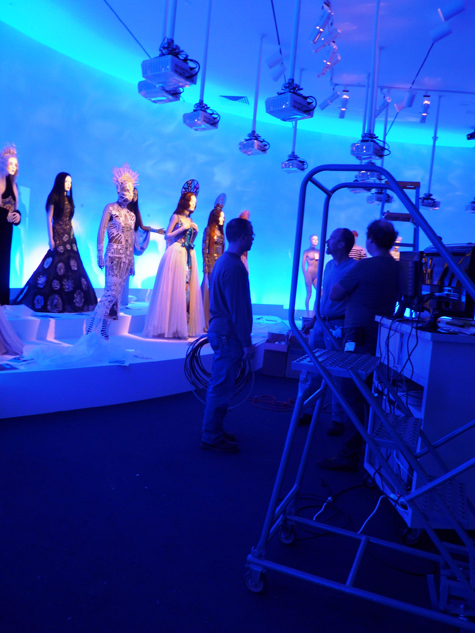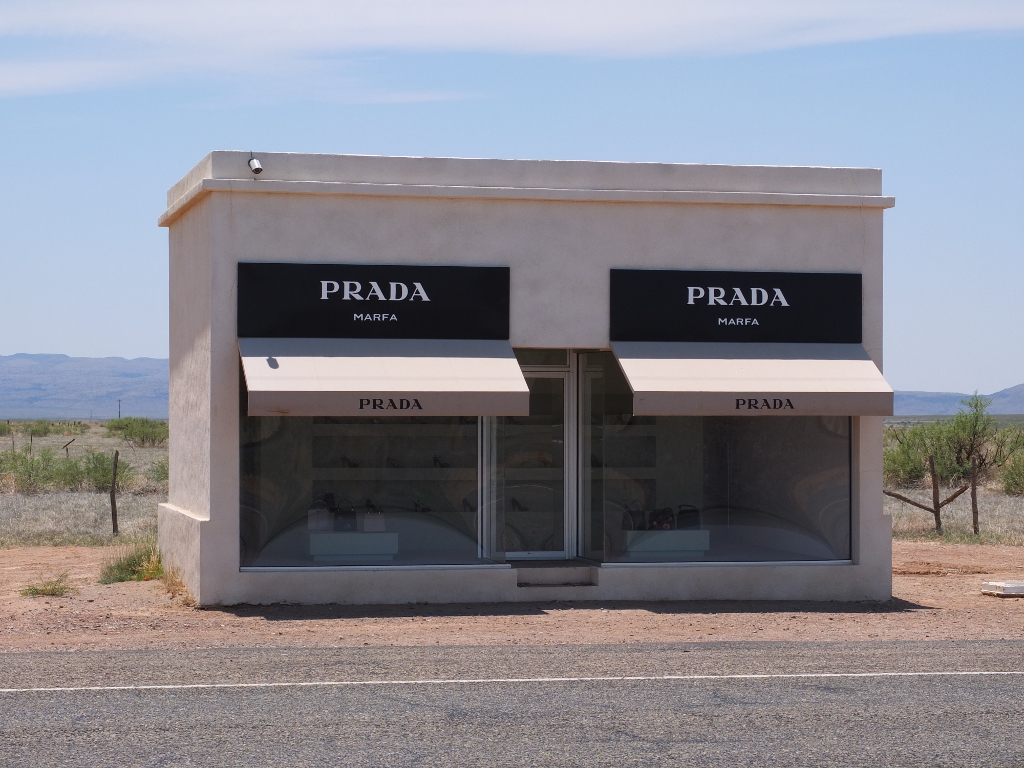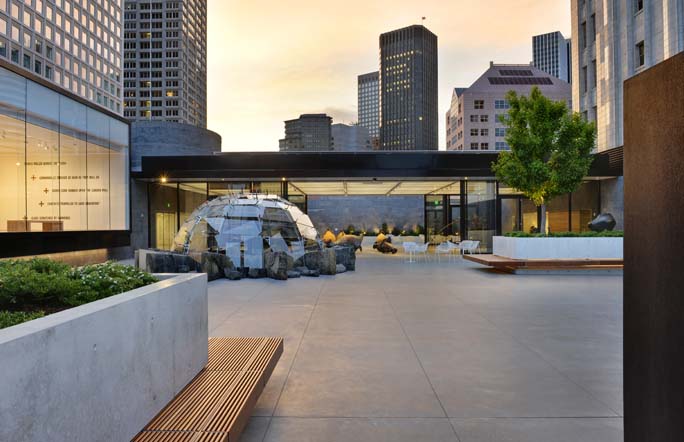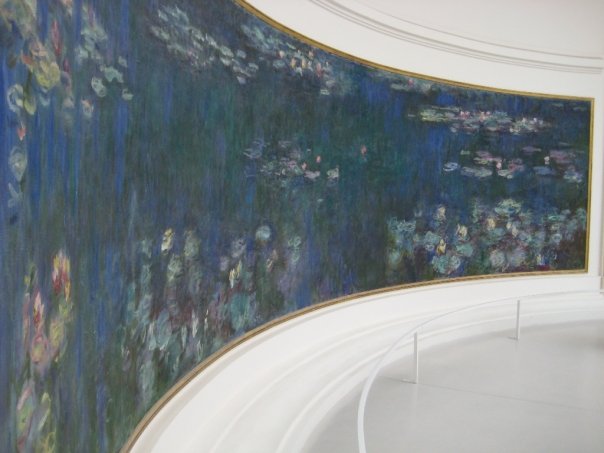Last week several of my colleagues and I began meeting about the logistics of deinstalling the exhibition The Fashion World of Jean Paul Gaultier: From the Sidewalk to the Catwalk once it closes on February 12. Gaultier is the world-renowned French couturier, whose fashion has been worn by everyone from Madonna to Lady Gaga. We found it difficult to believe that we were already making plans to take down a show in which we had invested so much time and effort installing. I was enormously privileged to be given the opportunity to help coordinate this installation as its exhibition registrar and to witness firsthand how so many of my colleagues transformed themselves daily into magicians in order to see this complicated project come to fruition in a tight timeframe. Permit me this walk down memory lane as I highlight stops, junctions, and detours on our way to what was the first of many openings, the VIP Host Committee Luncheon at 11:00 a.m. on November 9, 2011.
July 14–19 (3 months and 3 ½ weeks until opening)

This exhibition was the first fashion installation most of us had ever worked on, and its many technical requirements added extra complexities. A trip to the Montreal Museum of Fine Arts’ installation was vital for me and several of my colleagues. We take hundreds of pictures, ask pages of questions, and document mannequin mounting, lighting, and mechanical specifications.
October 17 (3 weeks and 2 days until opening)

Two 18-wheelers deliver the majority of the exhibition, with mannequins, mounts, and furniture in a regular truck, and costumes and works on paper in a climate-controlled one.
October 18 (3 weeks and 1 day until opening)

As soon as possible, we locate and unpack the Galleon headband so its dimensions can be verified for our preparators, who will make a mount for it, and our carpenters, who will build the proper-size “porthole” display case.

Preparators John Lendvay and Mary Nicolett assemble mannequins and take height measurements so they will know where to place them on the platforms in relation to the projectors, which will eventually bring their faces to life.
October 20 (3 weeks until opening)

Once the Odyssey gallery mannequins have been placed, the preparators hang the projectors a precise eighty-eight inches away from their noses so that the faces will align properly and not look like Picasso paintings.

LED strips are affixed inside the Urban Jungle gallery platforms before their frosted Plexiglas tops are installed.
October 21 (2 weeks, 6 days until opening)

Naked assembled mannequins await dressing in what was deemed the “morgue” but later transformed into the Exhibition Store.
October 24 (2 weeks and 2 days until opening)

Several tightly fitted leggings and stockings were packed directly on their legs to save wear and tear from dressing and undressing them at each venue. Thankfully, the mannequin body parts were labeled so we could easily match them to the proper legless torsos.
October 28 (1 week and 5 days until opening)

Tanel Bedrossiantz from Gaultier’s Paris atelier and local mannequin dresser Greg Goolsby join us on our first day of costume installation.
October 29 (1 week and 4 days until opening)


By the end of our second day, sixty mannequins throughout the exhibition have been dressed, including the catwalk models and their surrounding “punks.” We made it a priority to focus first on those with projections to allow as much time as possible for alignment and editing.

As hectic as the installation is, we find time to appreciate the humor – here Montreal’s organizing curator (and former model) Thierry Loriot demonstrates how to properly wear a Mohawk before attaching it to a mannequin head with double-stick tape.

Preparators and carpenter Dennis Bishop install the screen scrim and fine-tune the chain mechanism of the catwalk.
October 31 (1 week, 2 days until opening)

The porthole into the Urban Jungle gallery is finished, allowing visitors a sneak peek into the installation, and at the DMA’s Margot B. Perot Curator of Decorative Arts and Design Kevin Tucker, who is working with preparator Mike Hill on mannequin placement.

Mannequins patiently await their turn to be mounted on their catwalk platforms.

Tanel detaches a mannequin’s hands in order to install its many bracelets.

The “Hussar coat”-look silk faille skirt is unpacked. This piece has its own crate and is packed suspended over a cone support.
November 1 (1 week and 1 day until opening)

Gaultier atelier staff member Thoaï Nirodeth laces up the Chantilly lace body stocking. The Skin Deep gallery is the last to be dressed and installed because the back wall was built over a doorway we needed in order to move the large mannequin cases in and out of the space.
November 3 (6 days until opening)

We discover that a new mannequin has been sent for Madonna’s dancer’s costume in the Skin Deep gallery, and this one does not want to support himself (or Madonna) on all fours. After consultation with our conservator John Dennis and the Gaultier atelier, we build a mount to support him at the collar bone (surreptitously hidden by his black scarf).

A shipment of new outfits arrives from Paris, including the cowboy and cowgirl looks at the entry of the exhibition (created specifically for the Dallas installation), the 3-D “horn of plenty satin ribbon corset-style gown (which was just on the runway over the summer), and the costume from the film Kika. Upon unpacking the helmet, we notice the absence of a key accessory—an early model video camera. We locate similar ones on Ebay, but are fortunately able to obtain one overnight from a friend of a coworker who (thankfully) never throws anything away.
November 6 (3 days before opening)

The final shipment arrives from Montreal, including mannequins for the new outfits just arrived from Paris and clothing items with animal-related components that had been delayed due to customs problems.

Although it is standard practice to allow artwork twenty-four hours to acclimatize after arrival, time is of the essence and we unpack the final shipment immediately, which includes the doll with the ostrich-feather dress in the Boudoir gallery. In order to import items made from endangered animals or migratory birds, it is necessary to apply for government permits, which can take months to process.

Preparator Doug Velek installs the final two works on paper amid hair clippings in the exit gallery—the space that had been used as the “salon” of wig stylist Hugo Raiah.
November 7 (2 days before opening)

Preparator Lance Lander was instrumental in “lassoing” the numerous and complicated AV components in the exhibition, and also came to the rescue by lending the final accessories to complete the cowboy and cowgirl “looks.” (The lasso and Black Stetson were requested by the atelier at the last minute.)

Carpenter Dennis Bishop puts the finishing touches on the projector covers in the Odyssey gallery.
November 7, 8:30 p.m. (1 day and 9 ½ hours until opening)

Jean Paul Gaultier comes straight from the airport for his first walk-through of our installation. Several of us were on hand to welcome him and are privileged to watch the design genius at work as he adjusts the drapery of fabric and modifies accessories. To add more of his characteristic je ne sais quoi to the Chalk-striped mink pantsuit, he borrows a gold lamé turban from one of the female punks (now stylishly bald) and adds the Plastic bolero with gold thread embroidery.
November 8, 6:00 p.m. (17 hours before opening)

Registrars, preparators, and even our chair of collections and exhibitions scramble to clean, arrange, and affix the mirrored tiles to the platforms in the Metropolis gallery.
November 9, 10:00 a.m. (1 hour until opening)

After final consultation with Jean Paul Gaultier, his atelier staff hang the train of the Satin cage-look corset dress on the wall according to his specific direction.
Reagan Duplisea is the Assistant Registrar for Exhibitions at the Dallas Museum of Art.



















































